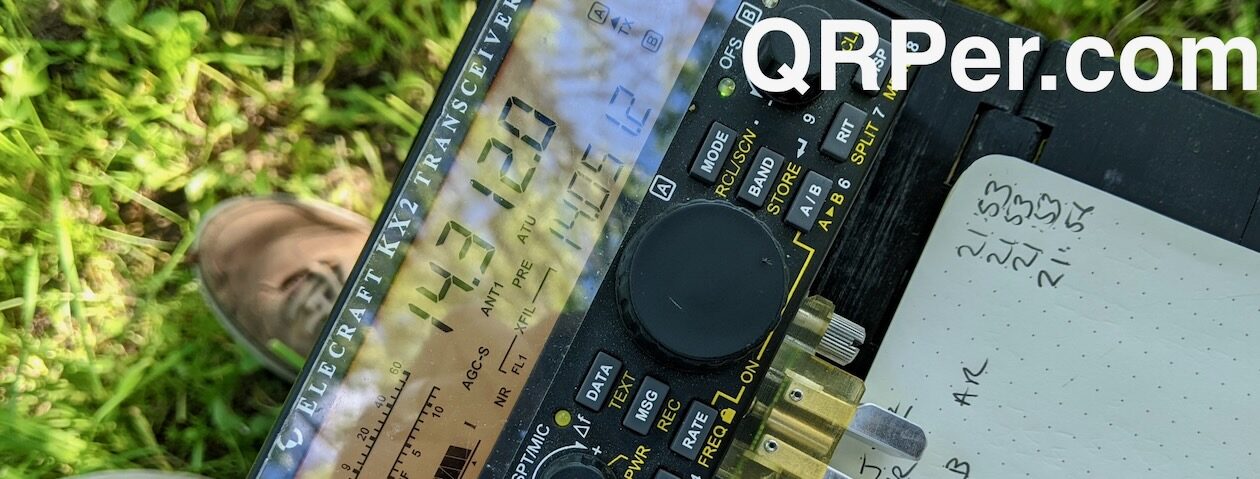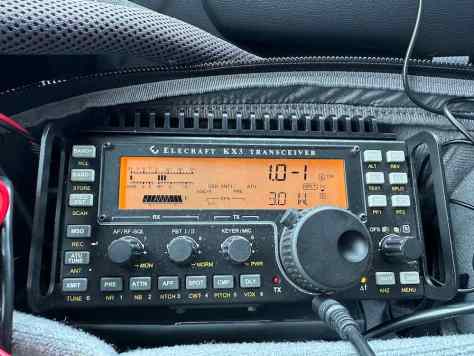Many thanks to Conrad (N2YCH) who shares the following field report:
AX1 Test using American Radio Supply AM-801 Window Mount: POTA Activation at Stuart B. McKinney Wildlife Refuge, K-0228
February 19, 2023
By: Conrad Trautmann (N2YCH)
If you’ve been reading the posts here on QRPer.com lately, you probably already know that the Elecraft AX1 has proven to be an excellent antenna for POTA activations for CW, SSB and Digital modes.
Personally, I used it for a New York City POTA rove I did at the end of 2022 and was able to activate four parks in one day all over Manhattan.
Recently, Alan, W2AEW contributed a story to QRPer.com detailing how he used a window bracket he constructed with an AX1 to do a CW park activation from his car. I’ve actually done a few digital activations from the car using the AX1, however, I used the tripod with the Elecraft tripod adapter and ran coax to it out the window and draped the counterpoise down the hood or trunk. This has worked well except for windy days where it would blow over. I was intrigued by the possibility of using the window mount and a number of the commenters to Alan’s post suggested sources for these types of mounts. I ended up ordering an AM-801 from American Radio Supply.
https://www.americanradiosupply.com/am-801-window-antenna-mount-bnc-connectors/
Since the AX1 depends on a counterpoise wire to operate properly, the first thing I did after receiving the AM-801 mount was to drill a hole in the base for a screw and a wing nut. The base is painted black, so I got my continuity meter out to double check that the screw was making a good ground, which it was. I had to bend the mount up slightly for the antenna to be vertical, since my Jeep windows don’t have much of an angle to them. I’m sure it would be just right for most cars.
My next step was to give it a try.
I headed out to Stratford, CT to Stuart B. McKinney Wildlife Refuge, park K-0228 to see how it would work with my Elecraft KX3. My experience with the KX3 has been that it can tune to a 1.0:1 SWR into just about any antenna I put on it. It’s pretty amazing. However, I wanted to see what an antenna analyzer would measure just to see if I was close to resonant or not. I brought my RigExpert Stick 280 and used the bluetooth mobile app on my iPhone to run sweeps on it for 40, 20 and 17 meters.
I began my test on 40 meters, thinking maybe there was still some life to the band when I arrived around 9am. I was wrong about that, by the way. By the time I got set up I was only picking up a few stations. I used the AX1’s supplied 33’ counterpoise wire and since I had my electric fence post with me in the Jeep (pictured above), I used it to keep the counterpoise stretched out and elevated off the ground. My first sweep of the antenna with the analyzer showed it resonant at 7.5 MHz.
A little high for the licensed ham bands. I thought, I’ll adjust the antenna to lower the frequency a bit, but realized that in order to lower the frequency, I needed to make the antenna longer. However, the antenna was already fully extended, I couldn’t make it longer. That left the counterpoise. I could make it longer or shorter to adjust the SWR. Since it was already fully extended, I shortened it up by a foot to see what that would do.
That took the dip up to 7.6 MHz, which was going the wrong direction. I had to add some length to the counterpoise. Since I didn’t have any more wire with me, I used my Amazon Basics metal ruler counterpoise (see post here for more detail on that) to add some length.
By adding a few feet, I was able to lower the resonant frequency down to 7.2 MHz which would work.
But if you look at these sweeps, you’ll notice that the bandwidth is fairly narrow and for 7.074 MHz, which is where I operate FT8, the SWR was still pretty high. I tried adding and subtracting counterpoise but to no avail, that was the best I was going to get. The KX3 tuned 1.0:1 on 7.074 MHz and I made one QSO before I decided to move to 20 meters. I also discovered that I was dealing with a little RF feedback. I could have used a choke balun in the RF cable to fix that, but I didn’t have one with me. I had to lower the power a few watts to solve that problem.
To go to 20 meters, I switched to the 13’ counterpoise wire and removed the 40 meter coil from the antenna. As with 40 meters, my first sweep showed minimum SWR at a higher frequency than I wanted, dipping near 15 MHz. I needed to add counterpoise again and after trial and error found that adding two and half feet gave me an SWR of 1.05:1 at 14.074 MHz. You’ll also see that the bandwidth on this frequency is better and had I chosen to move up the band to do SSB, I wouldn’t have had to retune the antenna.

On 20 meters, using five watts I was able to make enough contacts to officially activate the park.
Finally, since I was all set up and had the analyzer along, I decided to try flipping the switch on the AX1 to 17 meters and see how I could do on that band. I swept the antenna after the switch flip and found resonance had moved to 20.8 MHz, once again, too high for the ham bands. After more trial and error with the counterpoise, I was unable to tune for resonance in the ham bands using the window mount. The lowest I could get it was about 19 MHz. I did decide to try one last thing before I gave up. I abandoned the window mount and went back to my tripod mount and put the antenna on the roof of the Jeep and draped the counterpoise down the hood.
A sweep then showed an SWR of 1.8:1 at 18.1 MHz. It was very narrow though and I’m not sure how the antenna would perform up and down the band. I was able to tune the KX3 to 1.0:1 on 18.1 MHz and I was able to make a few more QSO’s on that band.
Here are my takeaways from my experiment.
First, I have no idea if Elecraft ever intended or guessed anyone would try and use their antenna in this manner. In most use cases I’ve seen with the AX1, the antenna is connected directly to Elecraft’s transceivers. So, my review here is in no way a reflection of the quality of the antenna or its performance, it’s purely an experiment to see if it can be adapted for my use case, which was to use it with the AM-801 window mount. Also, who knows what variables to the tuning I introduced with the car, elevating the counterpoise and the length of the cable on the window mount?
All that said, I made contacts on all three bands using QRP power. I think it’s safe to say that it worked the best on 20 meters using the window mount. I’d recommend having a bit longer counterpoise wire or extra on hand to extend the ones that come with the antenna, since I needed to extend it to find resonance in all cases. I was able to tune it for 40 meters even though the band was dead by the time I was ready to use it. Using the analyzer to try and find resonance on 17 meters didn’t work as well, but it’s likely the KX3 ATU could have made up for the mismatch. Here’s a map of my contacts for the day [click to enlarge], not too bad!















Nice writeup, Conrad. Your measurements look close to what might be expected based on the Elecraft Theory of Operation Document:
“The secondary resonance (~19 MHz) was chosen to allow lowloss ATU-based matching to both 17 and 15 meters. Far-field measurements of this scheme – compared to the use of
individual coils for all three bands – show under 1 dB of
difference. “
Thanks for the details about working the bands with the AX1. Especially your experience with the counterpoise. I am planning some pota activation s here with the newly acquired AX1 and was looking for counterpoise experiments.
First of all, I am a big Elecraft fan… the KX2 is like dating a Super Model without the drama! But I’ve had limited success with the AX1.
On the other hand, Thomas & many others have had repeatable, demonstrated field results….
I like this mount! I plan on buying it… it’s perfect to give me more experience in mastering this antenna. Thanks for the post!
Thomas: Thanks for all of your recent AX1 posts. These have inspired me to dust off my AX1 and put this fun little antenna to good use. 72, Craig WB3GCK
Conrad N2YCH:
What tripod is pictured in the Maxpedition kit in the second photo?
Thanks.
Hi Matt,
It’s an Amazon Basics Lightweight Mini Tripod that I bought for $9.99
We’ll, guess I have two things to do in Stratford.
I tend head to NYC/Bronx/Queens/Tappan Zee Bridge when I want to get out
I read this post and was looking for a quick portable Antenna . I got a pair of (tr)uSDX Rigs so I ordered AX1pack seems Elecraft is got a backlog on orders guess the Sale price they offered and the couple post I seen about really pump orders waiting to see when it arrives
When using a shortened antenna plus (somewhat) elevated counterpoise plus tuner – I have also had to adjust the counterpoise length to get a match. I have to wonder if the counterpoise is the actual antenna radiator, and the expensive “antenna” is just a tuning stub! I would welcome an explanation of why my theory is false!
Hi Jeff,
I believe that the antenna is directly connected to the center conductor of the BNC connector, which is connected to the center pin of whatever radio you use to transmit via the transmission line/RF cable. The center pin is where the RF output is generated from inside the transciever. The outer conductor is tied to ground usually, which is what the counterpoise on the AX1 is connected to. So while I don’t think the counterpoise is actually radiating, the orientation and length of it can certainly have an effect on pattern and direction of the radiated signal.
Hi Conrad – I see what you’re getting at, and the transmitter does put the energy out on the center pin. But we’re talking about electromagnetic waves here, so the energy really spreads out through the whole antenna system. One half of a dipole isn’t just sitting there dead, is it? Here’s a practical example: if you’ve used an end-fed half-wave (or read any discussion of them) you’ll know that “the coax is the counterpoise” and you have to be careful that rf doesn’t get back into your rig. So, I think the counterpoise can and does radiate – it’s just not what we expect to be the primary radiator. In my comment, I’m saying that, if the primary radiator is very inefficient, maybe the part of your signal that people hear is coming from the counterpoise.